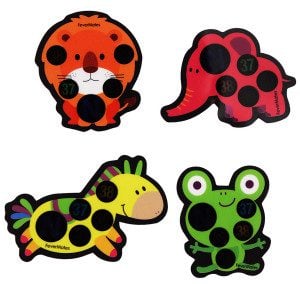Stick On Thermometers A Great Health Care Product for Kids
 Any parent can attest to the fact that kids just hate thermometers. Whether it’s a very little one who doesn’t understand and wants that thing away from his mouth or underarm (or worse) right now or a somewhat older tyke who, being sick and cranky, is in no mood to cooperate, taking a sick child’s temperature can be more challenging than solving a Rubik’s Cube. In our modern world there’s a solution for everything, and this is no exception.
Any parent can attest to the fact that kids just hate thermometers. Whether it’s a very little one who doesn’t understand and wants that thing away from his mouth or underarm (or worse) right now or a somewhat older tyke who, being sick and cranky, is in no mood to cooperate, taking a sick child’s temperature can be more challenging than solving a Rubik’s Cube. In our modern world there’s a solution for everything, and this is no exception.
Temperature Options
Parents have a variety of options for checking the temperature of a sick child. Here’s a quick overview:
1. Under the tongue style. A glass or digital thermometer is used, and the child must hold the thermometer under their tongue before an accurate temperature is given. This method is not recommended for children of 5 years and under.
2. Ear thermometers. These handy thermometers use infrared rays to take the temperature of the ear canal. They are recommended for children aged 6 months and above, but they require the child to remain still until the device has recorded a temperature.
 3. Pacifier thermometer. While this option seems like a good one, it can be difficult to use on newborns. Most of these thermometers are required to stay in the mouth for a minimum of 3 minutes before giving an accurate reading.
3. Pacifier thermometer. While this option seems like a good one, it can be difficult to use on newborns. Most of these thermometers are required to stay in the mouth for a minimum of 3 minutes before giving an accurate reading.
4. Stick On Thermometers. This style of thermometer uses liquid crystals to detect body temperature, and change colours to provide readings.
While all of the options are available to parents today, many parents are not familiar with the technology or option of the temperature strips.
 FROM INDUSTRY TO IN THE HOME
FROM INDUSTRY TO IN THE HOME
Realising the application’s promise in the sphere of paediatric care, the stick on thermometers indicator for kids was soon developed. Naturally, there are always two main questions about these indicators are they accurate, and are they safe? The answer to both questions is certainly ‘yes’. Those currently on the market measure in one degree Celsius increments, from a normal 37 degrees usually up to about 40 degrees Celsius designed in such a way since at that point one should immediately be consulting a medical professional. A common way to show a child’s temperature is in between two degree readings is for both to light up.
The next requirement is that these stick on thermometers be safe for human use. Thermochromic liquid crystals were chosen not only for their excellent ability to accurately be calibrated and display temperature but also because of their stability and ease with which they can be safely enclosed (source: LCRHallCrest ). Construction of all major brands’ offerings seem to be uniformly free of latex and other materials to which allergies are common. Similarly, hypoallergenic medical grade adhesive is used rather than a generic kind that may cause rashes or other negative skin conditions. Though they are strong enough to remain attached for up to 48 hours, removal is painless.
KID APPROVED
Manufacturers have added a level of creativity to the temperature stick option, and not only do they work, they’re safe and they’ll a parent’s life a whole lot easier. Just to ensure complete kidapproval, manufacturers tend to make their designs fun, incorporating themes that kids will love. Mediband’s Fevermates Stick On Thermometers, for example, are all brightly coloured woodland creatures. In the field of pediatric first aid, stick on thermometers temperature indicators look to be a winner.


Thank u